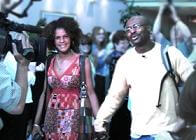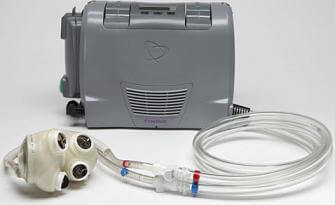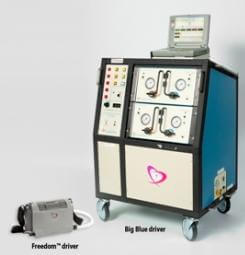
On May 3rd, Charles Okeke in Phoenix, Arizona appears to have become the first person in the US to take a total artificial heart out of the hospital and go home. Developed by SynCardia, the total artificial heart replaces both ventricles and all four valves of the human heart, allowing a patient to live for years while waiting for an organ transplant. Typically the artificial heart is powered by a 418 lb (~190 kg) machine called Big Blue, but SynCardia recently received FDA Investigational Device Exemption to try out their 13.5 lb (6.1 kg) backpack device called the Freedom Driver. An apt name considering it allows Okeke to live at home with his wife and kids. Check out the remarkable details in videos from CBS News and SynCardia below.
There are roughly three thousand people on the waiting list for heart transplants in the US (with similar numbers in Europe and South America). Of those three thousand, only about two thousand receive a new heart each year, with an average waiting time between one to two years! The total artificial heart serves as a bridge, allowing those whose hearts fail to survive long enough to receive a transplant with a success rate of about 80%. It costs about $125,000 with a yearly upkeep around $18,000. It has been in use since 2004, with 850 recipients so far, each spending an average of 144 days with the device. Some, however, have spent more than two and half years on the total artificial heart system. Okeke received his back in September of 2008.
Okeke will be the first of several in SynCardia’s FDA approved IDE trial for the Freedom Driver. An expected 60 patients will receive the device. Half of these will be allowed to go home while the other half continued to live in hospitals. Both groups will still be eligible for heart transplants. The tubes running out of the chest provide a risk for infection, and there is danger that the heart itself could develop blood clots (though it is specially designed to avoid them).
The Freedom Driver, like its Big Blue predecessor, uses electricity to provide pneumatic pressure that powers the total artificial heart. Sensors in the Freedom Driver allow it to correctly monitor that pressure to keep the heart beating at the right rhythm and strength. The Freedom Driver is powered by two large batteries, which can be recharged either from a wall socket or car outlet. No repair or upkeep for the device will be performed by the patient – a new device will be express delivered to the patient in the case of a problem (assuming the patient doesn’t have to be hospitalized). The Freedom Driver is further explained in this introduction to the device by SynCardia.
While it’s very likely that Okeke and many of the other participants will eventually be able to abandon their Freedom Drivers and artificial hearts in favor of real human organs, I find it remarkable that they could live indefinitely on the current systems. Even a decade ago an artificial heart would have seemed like science fiction to many people around world. Now, you can take one home. In another ten years will we no longer consider these devices a bridge but rather a full replacement? The range of physical activity one can perform while using the artificial heart is remarkable. Here’s video of a woman boxing while using the older Big Blue power supply:
For now the total artificial heart is still merely the best of a bad situation. The Freedom Driver gives a remarkable amount of mobility to its user, but they are still a long way from true freedom. Other approaches may find a more permanent and biological solution to heart damage. Stem cell injections may help repair hearts, or even be used to grow a completely new organ. As with so many other problems in medicine, heart damage is likely to see a series of stop-gap solutions using robotic systems like the total artificial heart until biological and genetic approaches can be perfected. Until then, it’s good to see Mr. Okeke will be able to enjoy the company of his family in his own home.
Further images and video:


[image credits: SynCardia]
[source: SynCardia Press Release and website]


